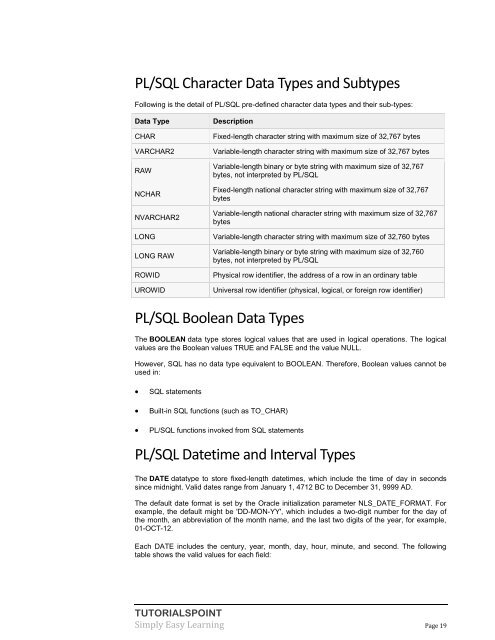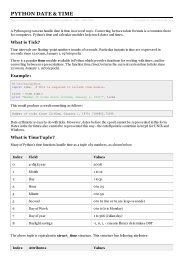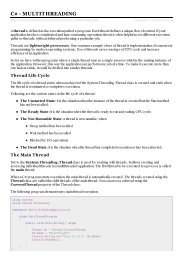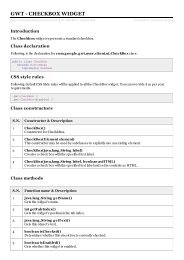download pl/sql tutorial (pdf - Tutorials Point
download pl/sql tutorial (pdf - Tutorials Point
download pl/sql tutorial (pdf - Tutorials Point
You also want an ePaper? Increase the reach of your titles
YUMPU automatically turns print PDFs into web optimized ePapers that Google loves.
PL/SQL Character Data Types and Subtypes<br />
Following is the detail of PL/SQL pre-defined character data types and their sub-types:<br />
Data Type<br />
CHAR<br />
VARCHAR2<br />
RAW<br />
NCHAR<br />
NVARCHAR2<br />
LONG<br />
LONG RAW<br />
ROWID<br />
UROWID<br />
Description<br />
Fixed-length character string with maximum size of 32,767 bytes<br />
Variable-length character string with maximum size of 32,767 bytes<br />
Variable-length binary or byte string with maximum size of 32,767<br />
bytes, not interpreted by PL/SQL<br />
Fixed-length national character string with maximum size of 32,767<br />
bytes<br />
Variable-length national character string with maximum size of 32,767<br />
bytes<br />
Variable-length character string with maximum size of 32,760 bytes<br />
Variable-length binary or byte string with maximum size of 32,760<br />
bytes, not interpreted by PL/SQL<br />
Physical row identifier, the address of a row in an ordinary table<br />
Universal row identifier (physical, logical, or foreign row identifier)<br />
PL/SQL Boolean Data Types<br />
The BOOLEAN data type stores logical values that are used in logical operations. The logical<br />
values are the Boolean values TRUE and FALSE and the value NULL.<br />
However, SQL has no data type equivalent to BOOLEAN. Therefore, Boolean values cannot be<br />
used in:<br />
<br />
<br />
<br />
SQL statements<br />
Built-in SQL functions (such as TO_CHAR)<br />
PL/SQL functions invoked from SQL statements<br />
PL/SQL Datetime and Interval Types<br />
The DATE datatype to store fixed-length datetimes, which include the time of day in seconds<br />
since midnight. Valid dates range from January 1, 4712 BC to December 31, 9999 AD.<br />
The default date format is set by the Oracle initialization parameter NLS_DATE_FORMAT. For<br />
exam<strong>pl</strong>e, the default might be 'DD-MON-YY', which includes a two-digit number for the day of<br />
the month, an abbreviation of the month name, and the last two digits of the year, for exam<strong>pl</strong>e,<br />
01-OCT-12.<br />
Each DATE includes the century, year, month, day, hour, minute, and second. The following<br />
table shows the valid values for each field:<br />
TUTORIALSPOINT<br />
Sim<strong>pl</strong>y Easy Learning Page 19

















